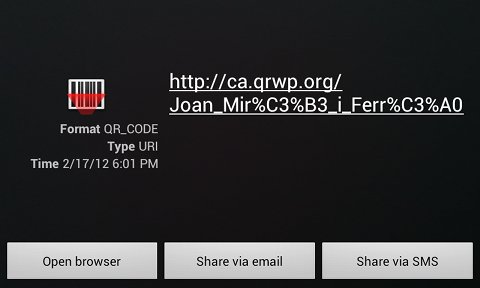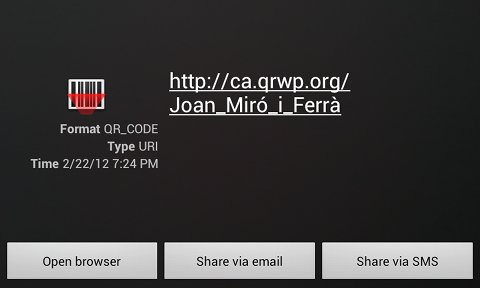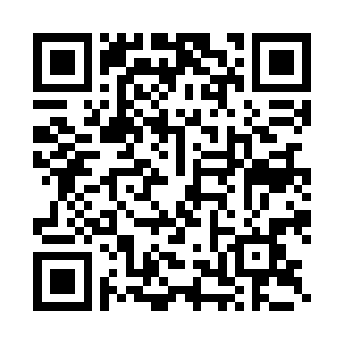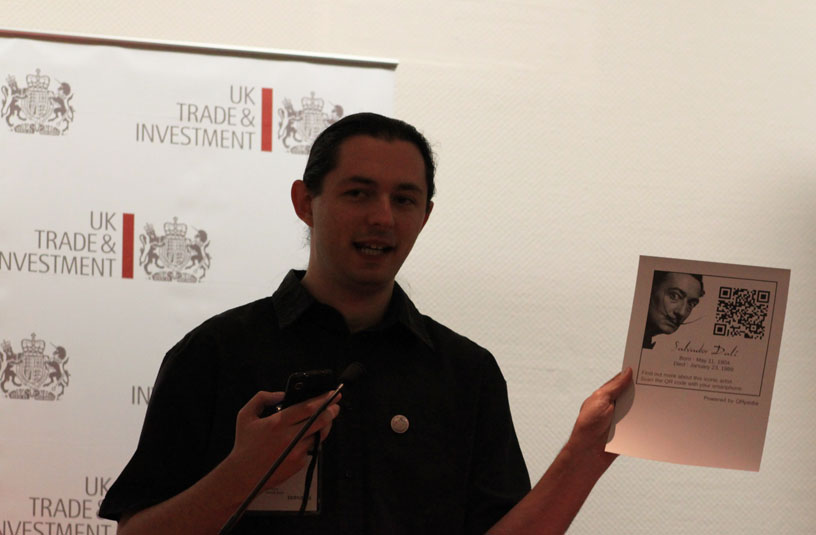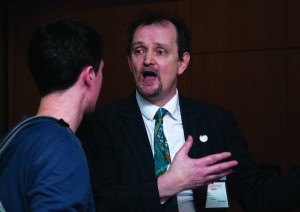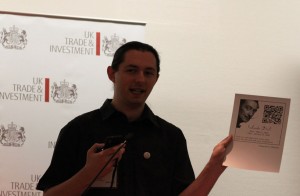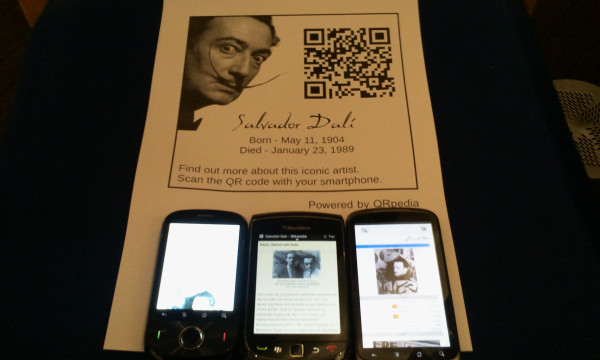Originally published on The Glam Wiki Experience.
ABSTRACT
Following the exhibition of “Joan Miró. The Ladder of Escape” which opened in Bacelona on October 15, 2011, a collaboration between the Fundació Joan Miró (Joan Miró Foundation) in Barcelona and the Catalan Wikipedia was proposed. The exhibition was open to the public in Barcelona from October 16, 2011 and March 18, 2012. Before it was shown at the Tate in London and later traveled to the National Gallery of Art in Washington DC.
The project intended to stick QR codes alongside some of the most prominent artworks of the exhibition. These codes linked to Wikipedia articles. These QRpedia codes identify the language of the phone and can therefore present the article -in the user’s preferred language- on Wikipedia, improving visitor’s experience.
On 14 September there was an edit-a-thon at the Fundació Joan Miró as a special contribution to the project, to launch this project.
This project was an example of a new way to visit museums and access to culture. As the mobile Internet is here, the desire to immediately satisfy our curiosity is also here. Visitors to museums do not wait to get home to read what the main features of an artistic movement or expand what he meant an artist to paint a particular job. QRpedia allows access to knowledge in their language, anytime, anywhere and for free.
CASE STUDY: QRpedia real use at Fundació Joan Miró in Barcelona.
PHASE 1. Content Generation
 |
| Foundation’s library is a treasure!! |
A few months before the start of the exhibition, the curators from the Joan Miró Foundation created a list of 17 outstanding works that would be shown at the forthcoming exhibit and sent it to the group of local Wikipedians.
They also put at their disposal all the necessary documentation and bibliography. To coordinate the project, a Wikiproject page was created in Catalan Wikipedia. A Wikiproject is a page or collection of pages on Wikipedia that serve to organize and coordinate users in improving articles about a particular topic. It is not a place to write articles for the encyclopedia, but an appeal for aid and coordination and for organizing group article writing.
So…during the following weeks, several Wikipedians spend their free time creating and expanding articles over the selected 17 works at the Catalan Wikipedia, maintaining contact with the Joan Miró Foundation through the figure of a project coordinator, who acted as a bridge and facilitator between the institution and Wikipedians.
To expand the Wikipedia community and socialize the project, Wikipedians asked for help to a group of art school professors and art historians and also to some local lovers of the work of Joan Miró, including teachers of the Edra Art School of Rubí. All of this people received a Wikipedia Workshop during the Summer, before joining the Wikiproject.
PHASE
2. Edit-a-thon, or how to socialize online onsite projects
.JPG/800px-Viquimarat%C3%B3_a_la_Fundaci%C3%B3_Mir%C3%B3_(21).JPG) |
| Wikipedians during the edit-a-thon |
One of the goals of the project was to build bridges of cooperation that generate synergies between the cultural sector and local communities to promote free knowledge. They are two existing groups working with the same goal – the maximum spread of knowledge with higher quality possible- but often do not know closely enough.
So project coordinators gave lots of importance to socialize and humanize the project. To overcome the mistrust, it was thought necessary that Wikipedians, curators and other museum professionals know each other and spend time together.
To this end, on September 14, 2011 an edit-a-thon was held at the Miró Foundation’s Library. It was a day where Wikipedians end up polishing the articles which they had been working with the best existing resources and references available at the library of the Foundation.
Days before this edit-a-thon meeting, the Wikipedians had already sent their questions and their requests for documentation to the librarians. So, that morning they where able to advance and improve the Wikipedia articles, referencing them with best quality information.
The event was held one month before the opening of the exhibition, so both curators and community had take time to review, refine and translate the contents. At the end of the morning, the museum professionals invited the Wikipedians to a lunch at the Foundation’s restaurant, where participants could interact and ask questions to each other in a more relaxed space.
_-_press_cam.JPG/800px-Viquimarat%C3%B3_a_la_Fundaci%C3%B3_Mir%C3%B3_(6)_-_press_cam.JPG) |
| We got loads of press coverage!! |
Then museum professionals reviewed the Wikipedia content and recommended some improvements and refined some details. It should be understood however that a Wikipedia article is never given for never completed, is a continual work-in-progress.
The edit-a-thon -and the project in general – had a strong coverage in the national press, interviews and mentions in national media like El Periódico, El Pais, Canal33, La2, RNE1, RAC1, El Punt Avui, Diari Ara or La Vanguardia, among others. Full list here.
This high coverage is due to a firm commitment by communication department of the Joan Miró Foundation, who believed from the PR capacity of the project and planned a strong media campaign to spread it.
PHASE 3. Internationalization
.JPG/448px-1_visitor_scaning_QRPedia_codes_at_Fundaci%C3%B3_Joan_Mir%C3%B3_(13).JPG) |
If the article don’t exist in the phone’s language,
system shows an option list with avaliables |
The process of creating and expanding articles was made in to Wikipedia in Catalan, preferred language of the local community, but the project had and international will, as the most interesting part of QRpedia is offering visitors the best possible information in their own language.
This is why the second phase of the project focused mainly on the translation of articles. The Catalan community of Wikipedians translated the the articles into Spanish and English, and then asked for international collaboration to translate them into other languages.
To get support from the international community, project leader looked for those users who had already edited or expanded Miró related articles on the other wikis (English, French, German…) and asked them for help. He also contacted people who were participating in existing wikiprojects related to visual arts or Catalan culture.
.JPG/800px-1_visitor_scaning_QRPedia_codes_at_Fundaci%C3%B3_Joan_Mir%C3%B3_(15).JPG) |
| Different tools for discovering the same artwork |
As Maarten D., a member of Wikimedia NL- defense, is always better and easier to ask for help to existing communities than spending your efforts in trying to create new ones.Roger Bamkin, creator with Terence Edent of QRpedia and member of Wikimedia UK, also helped in recommending some very active users in previous multilingual projects done in Wikipedia.
As a result of this ask for international collaboration, a week before the exhibition vernisage, all items were available in Spanish, Catalan, English, Russian and many other languages like German, Japanese, French, Finnish, Belarusian, Portuguese, Italian and Farsi, among others. The Wikiproject page was translated by the community into English and Finnish.
This means that dozens of volunteers around the world were reading, translating and adapting the articles about the artworks of Joan Miró for weeks, making this content available to a broader public in his native language.
RESULTS
SCANS:
This study of actual use of QRpedia codes has been based on a sample taken from October 1, 2011 and March 30, 2012. At this time there has been a total of 12.381 QR codes scanned inside the galleries of the Fundació Joan Miró.
|
ARTWORK (English name)
|
ARTWORK (Catalan name)
|
LANGUAGES
|
SCANS
|
|
|
Head of a Catalan Peasant |
Cap de pagès català |
6 |
864
|
|
|
Constellations |
Constel·lacions |
8 |
603
|
|
|
Naked Woman Climbing a Staircase |
Dona nua pujant l’escala |
6 |
952
|
|
|
The hope of a Condemned Man |
L’esperança del condemnat a mort |
6 |
693
|
|
|
The navigator’s hope |
L’esperança del navegant |
6 |
576
|
|
|
The Farm |
La Masia |
8 |
862
|
|
|
May 1968 |
Maig 1968 |
8 |
566
|
|
|
Hands flying off… |
Mans volant… |
5 |
899
|
|
|
Metamorphosis |
Metamorfosis |
7 |
799
|
|
|
Miró Otro |
Miró altre |
4 |
386
|
|
|
Still Life with Old Shoe |
Natura morta del sabatot |
10 |
994
|
|
|
Paintings on masonite |
Pintures damunt masonita |
7 |
1.169
|
|
|
Portrait of Vincent Nubiola |
Retrat de Vicenç Nubiola |
8 |
1.003
|
|
|
His Highness the Prince |
Sa Altesa el príncep |
5 |
906
|
|
|
Sa Majestat el Rei |
Sa Majestat el Rei |
6 |
372
|
|
|
Sa Majestat la Reina |
Sa Majestat la Reina |
5 |
385
|
|
|
Sèrie Barcelona |
Sèrie Barcelona |
7 |
226
|
|
|
Altres |
Altres |
nd |
126
|
|
|
|
|
Total scans
|
12.381
|
|
|
|
|
|
|
MONTH
|
SCANS
|
|
|
OCT |
2.124
|
|
|
NOV |
2.293
|
|
|
DEC |
1.990
|
|
|
JAN |
1.966
|
|
|
FEB |
2.014
|
|
|
MAR |
1.994
|
|
|
Total scans
|
12.381
|
|
|
|
|
|
ONLINE TOTAL VISITS:
The articles were available on Wikipedia. Therefore, content was not only accessible to the visitors in the exhibition, but to anyone who entered the popular online encyclopedia. The number of Miró-related visits to Wikipedia between October 2011 and March 2012, was much higher than the scans made inside the museum galleries, reaching more than 1.2 MILION VISITS.
Moreover, the activity of Wikipedians did not stop with the list of 17 selected works done by the curators, but it ended up producing more than fifty articles about Joan Miró and his work, and currently has presence in 49 different languages.
FURTHER USES
When someone scan a QRpedia code, system not only records the user’s language, but also records the time spended, the terminal type, how many scans he/she did in a time lapse … With all this information museum professionals can generated new ways of studying your public in a much more advanced way. Museums could get “hot maps” only watching which codes are consulted more often during a visit the route, and where are the actual “hot spots” of exhibits.
It can also serve as a tool to do market research before printing or order a catalog or a museum guide, because it allows analyzing the common query language done by users, even if this content does not exist on Wiki. As an example, Fundació Miró detected than they had lots of Korean requests but no wiki content and neither a printed guide.
|
|
|
|
|
|
SYSTEM
|
SCANS
|
%
|
|
|
Android |
3.289
|
27%
|
|
|
Apple |
8.308
|
67%
|
|
|
BB |
583
|
5%
|
|
|
Symbian |
146
|
1%
|
|
|
Others |
55
|
0%
|
|
|
Total scans
|
12.381
|
CONCLUSIONS
The QRpedia project is a very important opportunity for tourism, specially in bilingual country as Catalonia, where the text displayed at the museum’s walls must be at least in Catalan, Spanish and English.
QRpedia used in a public space (from museums to zoos) allows easy-to-access free information to the whole society, making it accessible in your language, letting institutions personalize the experience for visitors and improve accessibility to online content .
.jpg/800px-Qrpedia_codes_at_Fundaci%C3%B3_Joan_Mir%C3%B3_jan_2012_(4).jpg) |
| A visitor using QRpedia to read further about Joan Miró’s artwork |
It also allows citizens to become a part of the knowledge generated by the museums or any other cultural institutions, and easily engage with them, because Wikipedia articles are written collaboratively, and everyone is welcome to edit and improve it. In addition, a QR code occupies minimal space and is easy to add in an artwork label of the museum.
QRpedia is another example of new models of collaboration between cultural institutions and citizens, in which new technologies and open licenses allow citizens to take an active role in creating useful content for the whole society and engage with the preservation of heritage and culture.
First, museums are the custodians of knowledge and heritage. On the other hand, Wikipedia is becoming the family encyclopedia of the century, the gateway to knowledge, reaching millions of people every day. The Wikipedians help to analyze, study and disseminate the work done by museum professionals from around the world, giving value to the objectives of many of these institutions: disseminate knowledge and culture among society.
It’s time to combine the expertise of museums with the reach of Wikipedia, to build a proactive relationship that benefits both parties.
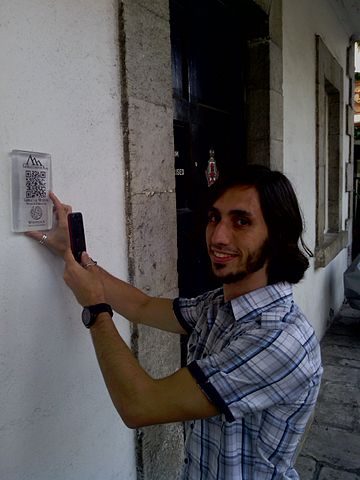
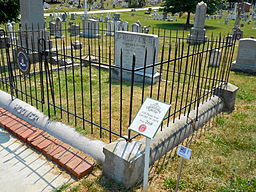

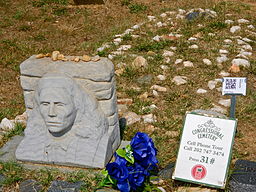


.JPG/800px-Viquimarat%C3%B3_a_la_Fundaci%C3%B3_Mir%C3%B3_(21).JPG)
_-_press_cam.JPG/800px-Viquimarat%C3%B3_a_la_Fundaci%C3%B3_Mir%C3%B3_(6)_-_press_cam.JPG)
.JPG/448px-1_visitor_scaning_QRPedia_codes_at_Fundaci%C3%B3_Joan_Mir%C3%B3_(13).JPG)
.JPG/800px-1_visitor_scaning_QRPedia_codes_at_Fundaci%C3%B3_Joan_Mir%C3%B3_(15).JPG)
.jpg/800px-Qrpedia_codes_at_Fundaci%C3%B3_Joan_Mir%C3%B3_jan_2012_(4).jpg)
